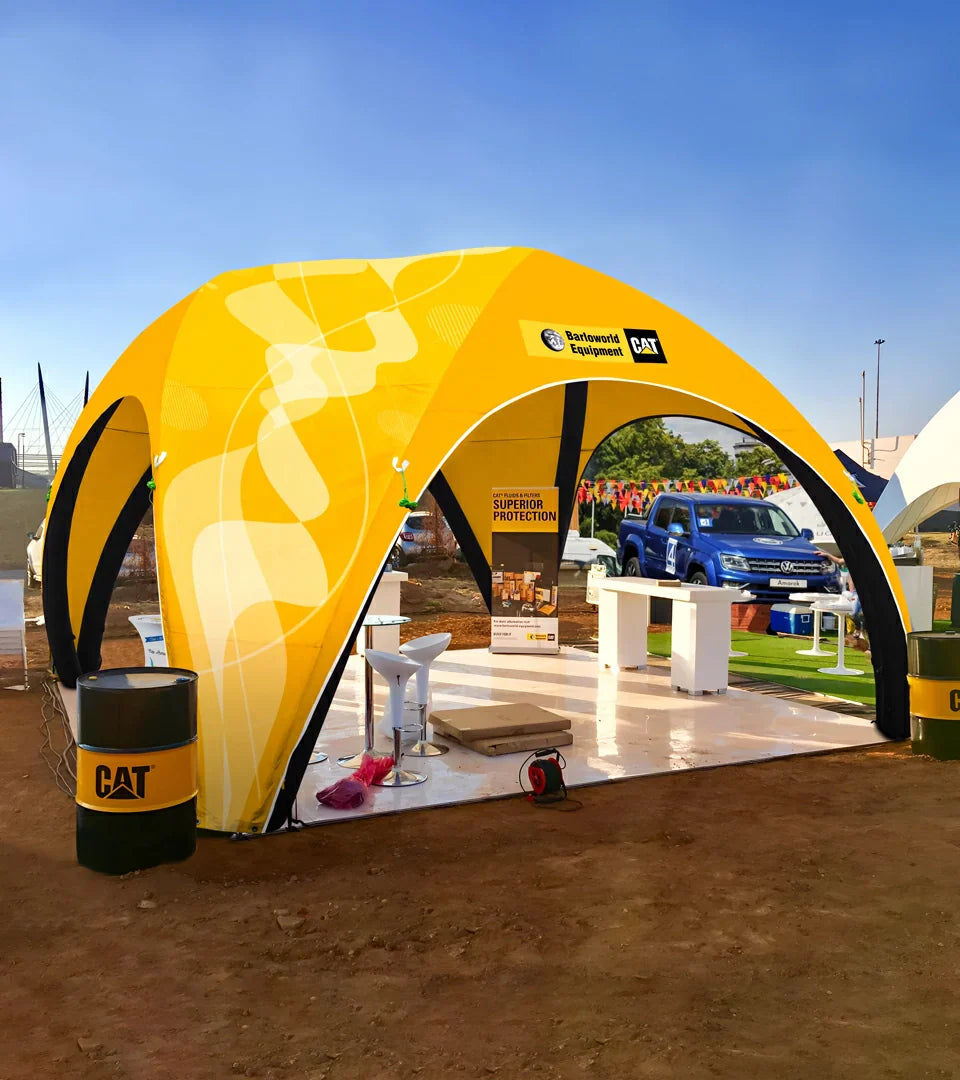Trade-show floors and outdoor festivals are noisy, visual battlegrounds. Yet among the sea of booths, the brands that dominate attention almost always have one thing in common—a branded canopy that turns 100 ft² of fabric into a billboard. This article shows you exactly how a pop-up tent printed with your logo draws a crowd, the design rules that make it work, and the simple metrics that prove the return on investment.
(Need the full buyer’s playbook on tent sizes, frame grades, or print methods? Jump to our Ultimate Guide to Custom 10 × 10 Pop-Up Tents for Businesses and Events for an end-to-end walkthrough.)
1 · The Pop-Up Tent: Your Portable Billboard
A standard 10 × 10 ft canopy offers roughly 100 square feet of prime, eye-level ad space. Unlike banner stands (limited height) or inflatable arches (single focal plane), a tent’s four-sided roof and valances command attention from every angle—even overhead drone footage.
- Cost per impression plummets after the first few outings because the structure is reusable for years.
- The canopy peaks above competitor tables and merchandise racks, acting as a “visual lighthouse” attendees spot long before they read name-badge text.
2 · Logo Placement & Size Rules
| Canopy Zone | Typical Viewing Distance | What to Print |
|---|---|---|
| Front valance (flap) | 10–20 ft, eye-level walk-bys | Full-color logo + concise CTA (≤ 4 words) |
| Roof panels | 20–50 ft, across aisles & drone shots | Bold icon or simplified logo mark |
| Side-walls | < 8 ft, at conversation distance | Social handles, QR codes, product images |
Design quick-wins
- Keep at least 20 mm of “safe space” around the logo edges on valances so stitching doesn’t clip the art.
- Size the primary mark so its tallest letter equals 40 % of valance height—legible at 20 ft.
- Maintain minimum 70 % color contrast between graphic and fabric to preserve readability under shade and direct sun.
3 · Color Psychology & Pantone Matching
- Warm hues (reds, oranges, yellows) literally raise heart rates and draw quick attention—great for youth brands or high-energy products.
- Cool hues (blues, greens) signal trust and calm—ideal for finance, healthcare, or eco-centric messaging.
- Modern dye-sublimation reaches ≈ 98 % of the Pantone® library on 600-D polyester, so insist your supplier matches your corporate palette exactly.
Pro tip: Ask for a digital proof plus a real-fabric strike-off photographed in daylight. That single extra step prevents nasty surprises when the tent arrives.
4 · A Step-by-Step Design Workflow
- Gather assets – Vector logo (AI/SVG/PDF) at ≥ 300 dpi for print scale.
- Supplier mock-up – Most vendors supply a 3D tent render within 24 h; request front, rear, and 45° angles.
- Iterate for readability – Test proofs on a phone from arm’s length (≈20 ft scale). If you squint, resize.
- Daylight test – View the final proof outside or under 5 500 K bulbs; approve only after colors still pop.
5 · Case Snapshot: Café Brew Wins 42 % More Leads
Café Brew, a regional coffee chain, swapped its plain white shelter for a caramel-brown tent with a frothing latte icon printed across the roof. During the Summer Taste Fest 2024:
- Foot-traffic clicks: 1 581 vs. 1 112 the prior year (+42 %)
- Instagram followers: +18 % in the week following the event (QR code printed on side-wall)
- Lead-capture ROI: Tent cost recouped after two festivals
Owner Maya Pedraza notes, “Customers told us they smelled coffee when they spotted the giant cup graphic—even before real aromas reached them. The tent was that visually suggestive.”
6 · Measuring ROI on a Branded Canopy
| Success Metric | How to Track | Good Benchmark |
|---|---|---|
| Foot traffic | Manual counter / tally app | +25 % vs. previous unbranded event |
| Lead captures | QR scans or contact-form fills | 3–5 % of passers-by |
| Social buzz | Unique hashtag mentions | 100 mentions per 1 000 attendees |
| Sales uplift | POS tags linked to event SKU | 1.5× booth cost within 90 days |
Action step: Print a unique QR code (with UTM parameters) on the back wall. Google Analytics then attributes conversions directly to canopy impressions.
7 · Beyond Trade Shows: Everyday Visibility
- Farmers’ markets & food-truck rallies – Tents double as directional signage.
- University fairs & career days – School-color canopies align with institutional branding.
- Storefront shade – When not traveling, set up in your parking lot; the canopy acts as free roadside advertising.
Each new context compounds impressions without additional media buy.
8 · Maintenance Tips for Long-Term Color Vibrancy
- Pack dry – Moisture breeds mildew that dulls ink.
- Spot-clean with mild soap – Harsh solvents strip dye-sub pigments.
- Store in a UV-proof sleeve – Prevents sun-fade when the tent rides in open trailers.
- Inspect Velcro & stitching each season – Loose seams blur outlines and reduce logo legibility.
9 · Conclusion & Next Steps
A pop-up tent emblazoned with a crisp, color-accurate logo transforms a simple shade structure into a mobile brand beacon that pays dividends every time you deploy it. Follow the placement, color, and workflow tips above, then track foot-traffic and lead captures to watch the ROI prove itself.
Ready for the full technical deep dive into frame grades, fabric weights, and print methods?
Explore our comprehensive Ultimate Guide to Custom 10 × 10 Pop-Up Tents for Businesses and Events to choose, maintain, and maximize your canopy.

